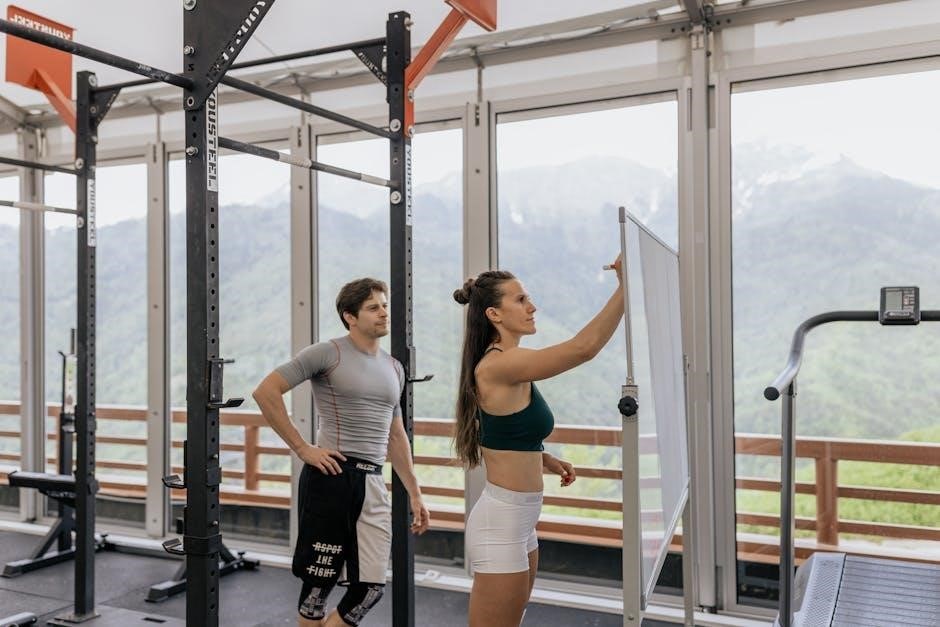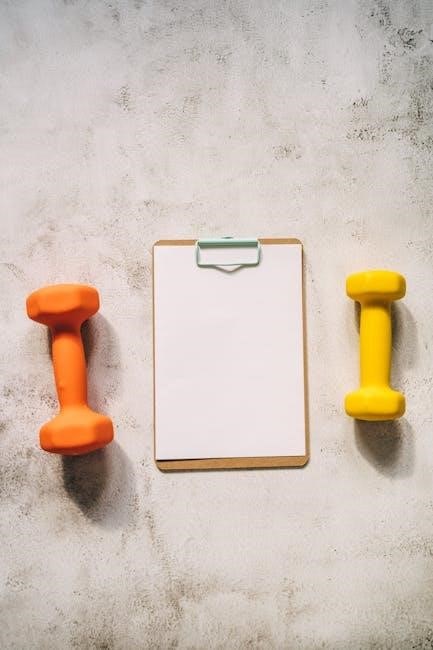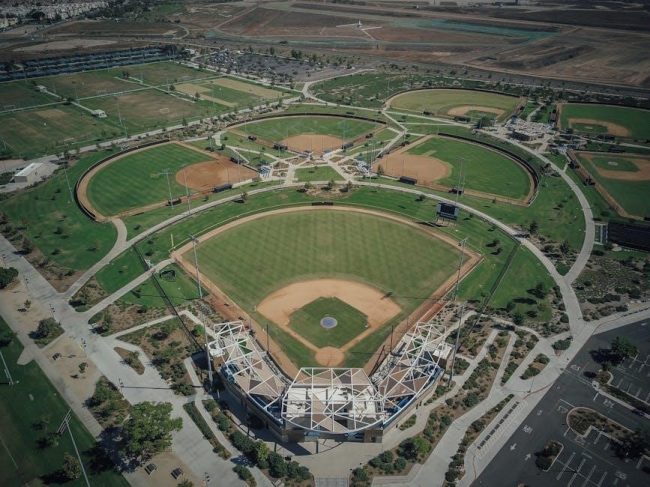Embark on a transformative journey with our structured 4-week glute workout plan, combining effective home and gym exercises․ Designed for all fitness levels, this program focuses on progressive overload and compound movements to build strength, tone, and confidence, achieving sustainable results and a stronger physique․
Understanding the Importance of Glute Training
Glute training is essential for both aesthetic and functional benefits․ Strengthening the glutes enhances posture, improves athletic performance, and supports daily movements․ Weak glutes can lead to lower back pain and poor posture, while strong glutes promote better biomechanics and reduce injury risk․ Beyond aesthetics, glute training boosts overall lower body strength, aiding in activities like walking, running, and lifting․ A well-rounded fitness routine must prioritize glute development to ensure proper muscle balance and long-term physical health․
Benefits of a Structured 4-Week Plan
A structured 4-week glute workout plan provides accountability, motivation, and clear progression, ensuring consistent effort for visible results․ It builds strength, endurance, and hypertrophy through focused exercises tailored for both home and gym settings․ The plan promotes gradual increases in intensity, preventing plateaus and encouraging continuous growth․ With a focus on progressive overload and balanced nutrition, this program helps you achieve a stronger, more toned physique effectively, while maintaining a sustainable and injury-free approach to fitness․
Setting Realistic Goals for Glute Development
Setting realistic goals is essential for successful glute development․ Aim to increase strength, muscle tone, and awareness of the glutes through consistent training․ Understand that significant growth takes time, so focus on short-term milestones like mastering form and progressively increasing weight․ Celebrate non-scale victories, such as improved posture or enhanced athletic performance․ Pair your workouts with proper nutrition and recovery to support muscle growth and maintain motivation throughout your fitness journey for sustainable results․

Week 1: Activation and Foundation
Week 1 focuses on activating your glutes and building a strong foundation with exercises like glute bridges and bodyweight squats․ This phase prepares your muscles for progressive overload and more intense workouts ahead, ensuring proper form and engagement from the start for effective glute development and overall lower body strength․
Glute Bridges for Muscle Activation
Glute bridges are an essential exercise for activating the glute muscles, especially the gluteus maximus․ They involve lying on your back with knees bent, then lifting your hips while squeezing your glutes․ This movement helps awaken dormant glute muscles, improving mind-muscle connection and preparing them for more intense workouts․ Performing 3 sets of 12-15 reps with controlled movements ensures proper activation and sets the stage for progressive overload in subsequent weeks․ Consistency in form and execution is key to maximizing results and preventing injury․ Glute bridges are perfect for beginners and advanced trainees alike, making them a cornerstone of any effective glute workout plan․
Bodyweight Squats for Strength Building
Bodyweight squats are a foundational exercise for building strength and engaging the glutes, quads, and hamstrings․ They involve standing with feet shoulder-width apart, then lowering the body while maintaining proper form․ This movement strengthens the lower body, improves coordination, and prepares the muscles for more advanced exercises․ Performing 3 sets of 12-15 reps ensures a solid foundation for progressive overload․ Focus on controlled movements and proper form to maximize results and prevent injury, making bodyweight squats a versatile and effective addition to any glute workout plan․
Progressive overload is a cornerstone of effective strength training, involving the gradual increase of weight, reps, or sets to challenge muscles and stimulate growth․ This principle is essential for building stronger, more defined glutes over the 4-week plan․ By consistently increasing resistance, you ensure continuous muscle engagement and avoid plateaus․ Whether through heavier weights or additional repetitions, progressive overload keeps your workouts dynamic and results-driven, making it a key strategy for achieving visible glute development and overall lower body strength․

Week 2: Hypertrophy and Intensity
Week 2 amplifies intensity with weighted squats, single-leg glute bridges, and deadlifts, targeting hypertrophy and full lower body engagement to maximize glute growth and strength development․
Weighted Squats for Glute Growth
Weighted squats are a cornerstone of glute development, engaging the glutes, hamstrings, and quads․ Using dumbbells or a barbell, this exercise promotes muscle hypertrophy and strength․ Focus on proper form, ensuring knees track over toes and maintain a neutral spine․ Progress by increasing weight or reps weekly․ This compound movement effectively targets multiple muscle groups, making it a key component of the 4-week glute workout plan․ Consistency and progressive overload will maximize results, helping to sculpt stronger, more defined glutes over time․
Single-Leg Glute Bridges for Balance
Single-leg glute bridges are an excellent exercise for improving balance and stability while targeting the glutes․ By lifting one leg, you challenge your core and glutes to maintain control, enhancing unilateral strength․ This variation helps correct imbalances and strengthens the gluteus maximus․ Perform with proper form, keeping hips level and squeezing at the top․ Incorporate 3 sets of 12-15 reps per leg into your routine for optimal results, ensuring progressive overload to maximize glute growth and overall lower body stability in the 4-week glute workout plan․
Deadlifts for Full Lower Body Engagement
Deadlifts are a powerful compound exercise that engages the entire lower body, including the glutes, hamstrings, and calves․ This exercise is exceptional for building overall strength and muscle mass․ By hinging at the hips and lifting with proper form, deadlifts effectively target the posterior chain, promoting balanced development․ Focus on maintaining a neutral spine and squeezing your glutes at the top of the movement․ Incorporate deadlifts into your routine with progressive overload to maximize engagement and results in your 4-week glute workout plan․

Week 3: Advanced Techniques and Variations
Week 3 introduces advanced exercises like barbell lunges and step-ups to target specific muscles for growth․ These variations enhance functional strength and glute development effectively․
Barbell Lunges for Targeted Growth
Barbell lunges are a powerful exercise for targeting the gluteus maximus, medius, and hamstrings․ Holding a barbell with an overhand grip, perform walking lunges with an upright posture․ Focus on controlled movements, ensuring the back knee nearly touches the ground․ This exercise enhances balance and strength while promoting muscle growth․ Incorporate progressive overload by increasing weights weekly․ Proper form is crucial to avoid injury, so prioritize a stable core and full range of motion․ Barbell lunges are a cornerstone of advanced glute development in Week 3․
Step-Ups for Functional Strength

Step-ups are an excellent exercise for functional strength, targeting the glutes, quads, and hamstrings․ Using a sturdy platform, step up with one leg, driving through the heel, and bring the other leg to meet․ Perform with bodyweight or add resistance using dumbbells or a barbell․ This exercise mimics real-life movements like climbing stairs, enhancing coordination and balance; Focus on controlled movements to maximize glute activation and avoid knee strain․ Step-ups are versatile, suitable for all fitness levels, and can be progressed by increasing step height or weight․
Side-Lying Leg Lifts for Glute Medius Activation
Side-lying leg lifts target the glute medius, essential for hip stability and preventing lower back pain․ Lie on your side, lift the top leg straight, then lower slowly․ This exercise improves balance, posture, and functional movement․ Perform 3 sets of 15-20 reps per side․ Add resistance with bands or weights for progression․ Focus on controlled movements to avoid strain and ensure proper activation․ This lift enhances overall lower body stability and supports athletic performance, making it a valuable addition to your glute workout routine․

Week 4: Maximum Intensity and Final Push
Push your limits with heavy deadlifts and Bulgarian split squats, maximizing glute engagement․ This final week intensifies the workout, ensuring a strong finish to your transformation journey․
Heavy Deadlifts for Maximum Engagement
Heavy deadlifts are a cornerstone of Week 4, targeting the glutes, hamstrings, and lower back for maximum engagement․ This compound lift builds significant strength and muscle mass, fostering a strong, athletic physique․ Focus on proper form to avoid injury, engaging your core and squeezing your glutes at the top․ Start with manageable weights and progressively increase the load, ensuring each rep is executed with control․ Deadlifts are a powerful tool for glute development, delivering results through intense, focused effort․
Bulgarian Split Squats for Hypertrophy
Bulgarian split squats are a powerful exercise for targeting the glutes, quads, and hamstrings, promoting significant hypertrophy․ By focusing on one leg at a time, this movement enhances balance and stability while maximizing muscle engagement․ Use dumbbells or a barbell for added resistance, progressing gradually to challenge your muscles further․ This exercise is ideal for building strength and definition, making it a key component of Week 4’s intense workout plan, designed to push your glutes to new levels of growth and endurance․
Glute-Focused Core Work for Stability
Strengthening the core is essential for glute development, as it enhances stability and overall performance․ Incorporate exercises like planks, bird dogs, and side planks to engage the transverse abdominis, obliques, and lower back muscles․ These movements improve posture, reduce injury risk, and ensure proper form during glute exercises․ A stable core allows for more effective engagement of the glutes, maximizing hypertrophy and functional strength, making it a crucial component of your 4-week glute workout plan for optimal results and long-term muscle stability․

Additional Tips for Success
Stay consistent, prioritize proper form, and ensure equipment is properly set up․ Track progress, stay hydrated, and maintain a balanced diet to support muscle growth and recovery effectively․
Progressive Overload: The Key to Growth
Progressive overload is essential for glute development, involving gradual increases in weight, reps, or sets․ Start with manageable loads and incrementally challenge your muscles weekly․ This approach ensures continuous engagement and growth․ Avoid overtraining by balancing intensity with proper form․ Use dumbbells or barbells for resistance, and consider bodyweight exercises as a foundation․ Consistency and tracking progress are vital to achieve visible results and maintain motivation throughout the 4-week plan․
Importance of Proper Form and Technique
Maintaining proper form is crucial for effective glute engagement and injury prevention․ Focus on controlled movements, engaging your core, and targeting the correct muscle groups․ Poor technique can lead to imbalances and potential harm․ Start with lighter weights to master form, then gradually increase intensity․ Prioritize exercises that activate the glutes without over-relying on secondary muscles․ Consistent attention to technique ensures sustained progress and maximizes the benefits of your 4-week workout plan․
Rest and Recovery Strategies
Adequate rest is vital for muscle growth and recovery․ Ensure 48-72 hours between glute workouts to allow tissues to repair․ Incorporate stretching, foam rolling, and low-intensity cardio to enhance blood flow․ Prioritize 7-9 hours of sleep nightly, as this is when muscle repair peaks․ Overtraining can hinder progress, so balance effort with recovery․ Proper hydration and nutrition further support muscle rejuvenation, ensuring you’re ready for the next session and maximizing the plan’s effectiveness․
Choosing the Right Equipment for Home Workouts
For effective home glute workouts, prioritize dumbbells or a barbell as primary tools for resistance․ Dumbbells are ideal due to their versatility and adjustability, allowing progressive overload․ A kettlebell or resistance bands can serve as alternatives if preferred․ If available, incorporate a bench for step-ups or hip thrusts․ While equipment enhances results, bodyweight exercises like glute bridges and squats remain effective․ Ensure proper technique to maximize gains and prevent injury, making the most of your available resources․

The Role of Nutrition in Glute Development
A well-balanced diet is essential for glute growth, providing the necessary nutrients for muscle repair and development․ Focus on lean proteins, complex carbs, and healthy fats to fuel your workouts and support recovery․

Macronutrient Breakdown for Muscle Growth
A balanced intake of macronutrients is crucial for glute development․ Aim for a diet rich in protein (1․2-2․2g per kg of body weight) to repair and build muscle tissue․ Complex carbohydrates provide energy for workouts, while healthy fats support hormone production․ Maintain a caloric surplus to promote muscle growth, but avoid excessive sugar and processed foods․ Proper hydration and timing of meals around workouts can further enhance recovery and progress․ This balanced approach ensures your body has the fuel it needs to maximize glute development effectively․
Meal Planning and Timing for Optimal Results
Strategic meal planning and timing are vital for maximizing glute growth․ Aim to space protein-rich meals evenly throughout the day, ensuring adequate intake around workouts․ Prioritize complex carbs and healthy fats to fuel energy needs․ Post-workout nutrition is key—consume a balanced meal with protein and carbs within 60-90 minutes to aid recovery․ Stay hydrated and avoid processed foods to maintain a clean diet․ Consistency in meal timing supports muscle recovery and growth, helping you achieve visible results by the end of the 4-week plan․
Hydration and Supplementation Tips
Proper hydration is essential for optimal muscle function and recovery․ Aim to drink at least 8-10 glasses of water daily, increasing intake around workouts․ Supplements like whey protein can support muscle growth, while creatine may enhance strength and endurance․ Consider adding fish oil for inflammation reduction and multivitamins to fill nutritional gaps․ Timing supplements correctly, such as taking protein post-workout, maximizes recovery․ However, rely primarily on whole foods and use supplements as additions to your diet for best results․

Common Mistakes to Avoid
Avoid over-training and neglecting rest days, as this can lead to injuries and hinder progress․ Poor form and inconsistent routines also undermine results, while ignoring the mind-muscle connection reduces effectiveness․
Over-Training and Its Consequences
Over-training can lead to injuries, muscle imbalances, and stalled progress․ Excessive focus on glutes without adequate recovery disrupts overall fitness goals․ Muscles need rest to grow, and neglecting this can cause fatigue and poor performance․ Over-training also risks injury from repetitive strain or poor form․ To avoid this, stick to the recommended twice-weekly glute workouts and ensure recovery days․ This balanced approach supports sustainable growth and prevents burnout, aligning with the structured 4-week plan’s goals of strength and toning without compromise․
Neglecting Rest Days and Recovery
Neglecting rest days and recovery hinders muscle growth and risks injury․ Muscles repair and strengthen during rest, not just during workouts․ Without proper recovery, fatigue and poor performance ensue, delaying progress․ Overtraining can lead to muscle imbalances and injury․ Schedule rest days as part of your routine to allow your glutes and lower body to heal and adapt․ This ensures sustainable growth and avoids burnout, aligning with the 4-week plan’s goal of balanced, effective training․
Not Focusing on Mind-Muscle Connection
Neglecting the mind-muscle connection reduces exercise effectiveness․ Without focusing on engaging your glutes during workouts, you risk poor muscle activation and diminished results․ This often leads to relying on secondary muscles, imbalanced growth, and increased injury risk․ To maximize progress, concentrate on squeezing and activating your glutes intentionally during each exercise․ This mental focus enhances muscle recruitment, ensuring targeted growth and stronger, more defined glutes by the end of the 4-week plan․
Celebrate your progress, evaluate results, and continue challenging your glutes with advanced techniques․ Stay consistent and patient for long-term success․ Download the PDF for future reference․
Evaluating Progress After 4 Weeks
After completing the 4-week glute workout plan, assess your progress by comparing photos, measurements, and strength gains․ Notice improvements in muscle tone, shape, and overall lower body strength․ Celebrate small victories and stay motivated, as visible results may vary depending on consistency and nutrition․ Track how exercises feel easier or require heavier weights, indicating growth and strength development․ Use this momentum to continue challenging your glutes and maintain a healthy, active lifestyle․
Continuing the Glute Journey Beyond 4 Weeks
After completing the 4-week plan, maintain momentum by gradually increasing weights or reps․ Incorporate variations like barbell exercises or advanced lunges to keep challenging your glutes․ Focus on consistency and patience, as significant growth takes time․ Pair continued training with a balanced diet to fuel progress․ Celebrate small achievements and stay committed to your fitness journey, ensuring long-term results and a stronger, toned physique․
Downloadable PDF Guide for Future Reference
A downloadable PDF guide offers a convenient way to track progress and maintain consistency․ This comprehensive resource outlines exercises, sets, and reps, ensuring clarity and motivation․ With a PDF, you can access your plan anytime, even offline, making it ideal for home or gym workouts․ It also serves as a long-term reference, allowing adjustments and keeping you committed to your fitness goals․ The guide is customizable, helping you stay organized and focused on achieving a stronger, toned physique․
